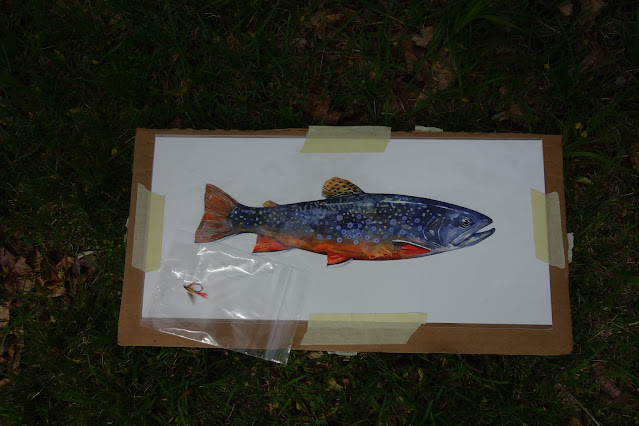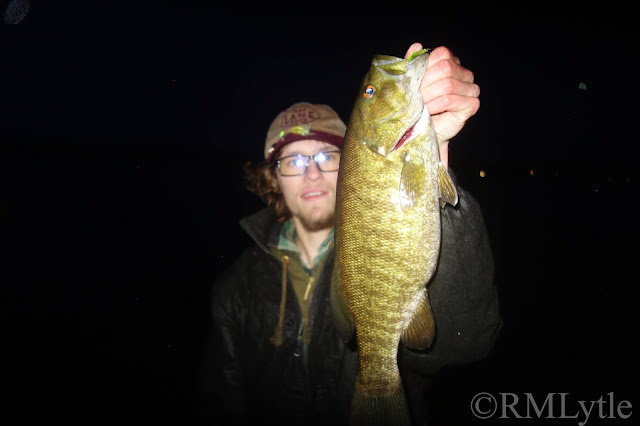Goldfish are a notable and often problematic invasive species found throughout the world. They are native to East Asia, were selectively bred to create the vibrantly colored ornamental variations seen today, and spread around the world for hundreds of years. They are one of the most popular aquarium fish and one of the most widespread domesticated fish. In the wild, goldfish can cause significant problems where they are not native. They reproduce rapidly and despite often being orange and poorly suited to remaining hidden, they quickly overpopulate. Though goldfish are certainly not apex predators, their presence usually disrupts whatever ecosystem they are released in.

I’ve encountered goldfish sporadically throughout the years in CT waters, but never any big enough to catch on the fly. Then, one day this spring, while looking for water snakes with my friend Bruce, we spotted a school of goldfish in a small public pond. I’ve since returned three times- once on my own and twice with Noah -specifically to fish for those goldfish. On the first visit I didn’t get any goldfish but I was able to determine what species were in the pond. Three that I saw were native fish: golden shiners, brown bullhead, and pumpkinseed sunfish. Two more, other than the goldfish, were invasive species: common carp and mosquitofish (whether they were eastern or western I am not sure, but western is more likely as westerns are the only of the two species so far confirmed in CT). There was only one common carp in the pond, an 18 pound or so fish likely introduced intentionally with the hopes it would do something to control weed growth.


On the second trip, Noah and I were more strategized. We brought bread to chum in the goldfish. The golden shiners and bullheads got to it first, and we got a couple bullheads each. It took a long time for any goldfish to come around. Eventually some did. I had on a size 16 Walt’s Worm under an indicator, but interesting fish would lose interest in the fly as soon as it sank to depth and suspended. They seemed far more interested in a moving fly. This was interesting to me because I’d seen the same behavior from lake chubsucker, a North American native fish. Lake and creek chubsucker both share a nearly identical niche with goldfish and are visually, anatomically and ecologically similar; a clear example of convergent evolution.
Eventually, I managed to get one of the two goldfish that were spending time in our baited area to take my little nymph, and after no fight at all I had lifer #178 at hand. It was certainly a pretty fish, ornately colored and lustrous. This fish was also completely unnatural: no undomesticated, uncultured, native goldfish would look anything like this, nor would such a fish be swimming in a pond in Connecticut were it not for human intervention. For some reason I really liked that little fish and felt compelled to catch more. When Noah wasn’t able to get his lifer on the first attempt, it was a good excuse for me to return for more.
 |
| Lifelist fish #178, goldfish, Carassius auratus. Rank: Species. |
On attempt two, we brought corn as well as bread. Our justification for that was how disinterested in the floating bits of bread the goldfish were and how hard it was for Noah to keep bread on the hook. Bread still helped draw in the hungry masses, and we had some goldfish come into the swim much sooner than we had the previous trip. This time I focused on golden shiners before the goldfish showed interest. I’ve become increasingly more obsessed with that species lately, as well. Unfortunately this pond seems not to hold any large ones.


Noah got the first goldfish- a lovely wild-type. That was exactly the color expression I wanted to catch, as it would be a nice contrast with the cultured ornamental version I’d already caught. I ended up getting three goldfish on the fly: a bright orange one, another with orange and black patterning, and an almost wild looking but still fairly colorful individual. They were actually surprisingly willing to eat and even chase a nymph. If it stopped moving, they lost interest. This is of course what we’d already observed on the trip before, but it was nice to know that behavior wasn’t a fluke.
Eventually I broke down, put on a piece of corn and caught a true wild-type. I’m not sure if these goldfish had simply been present and reproducing long enough for the more natural color genetics to arise or if some wild type individuals had been put in the pond originally. There wasn’t a notable variety of sizes, so I can’t be sure these fish are actually reproducing in that pond.
Catching those goldfish coincided with a general urge to catch colorful cyprinids. I’ve got this strange, previously non-existent compulsion to fish for ornamental fish. Next on the list, something I’d been after for years: mirror carp. Another genetic variation cultivated for ornamental purposes.
Until next time,
Fish for the love of fish.
Fish for the love of places fish live.
Fish for you.
And stay safe and healthy.
Thank you to my Patrons; Erin, David, John, Elizabeth, Brandon, Christopher, Shawn, Mike, Sara, Leo, C, Franky, Geof, Luke, and Noah for making Connecticut Fly Angler possible. If you want to support this blog, look for the Patreon link at the top of the right side-bar in web version.
Edited by Cheyenne Terrien

















































